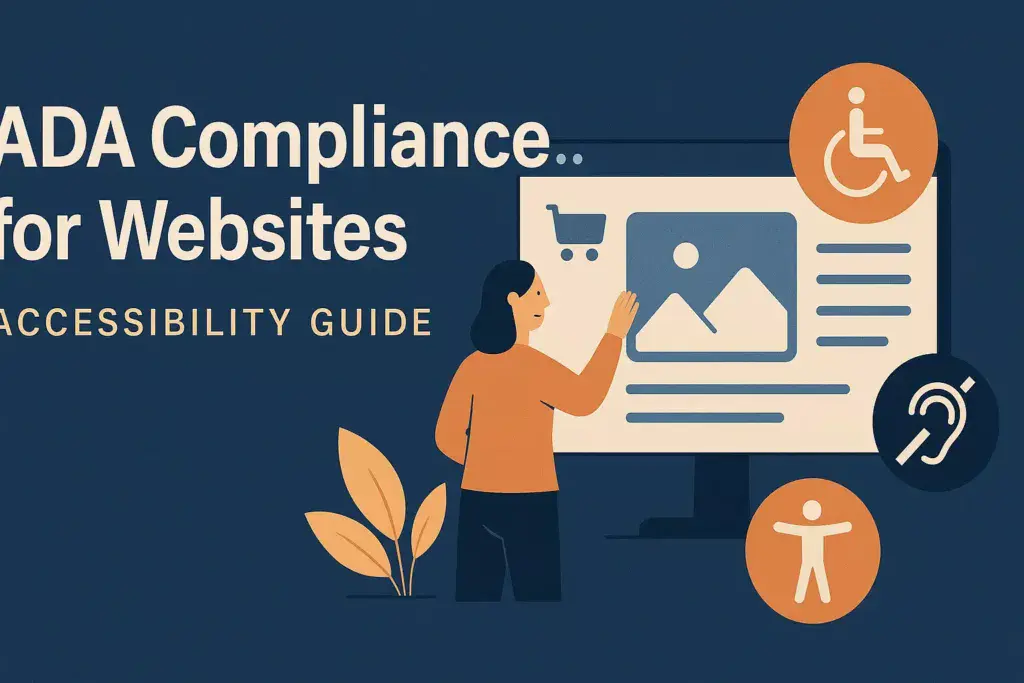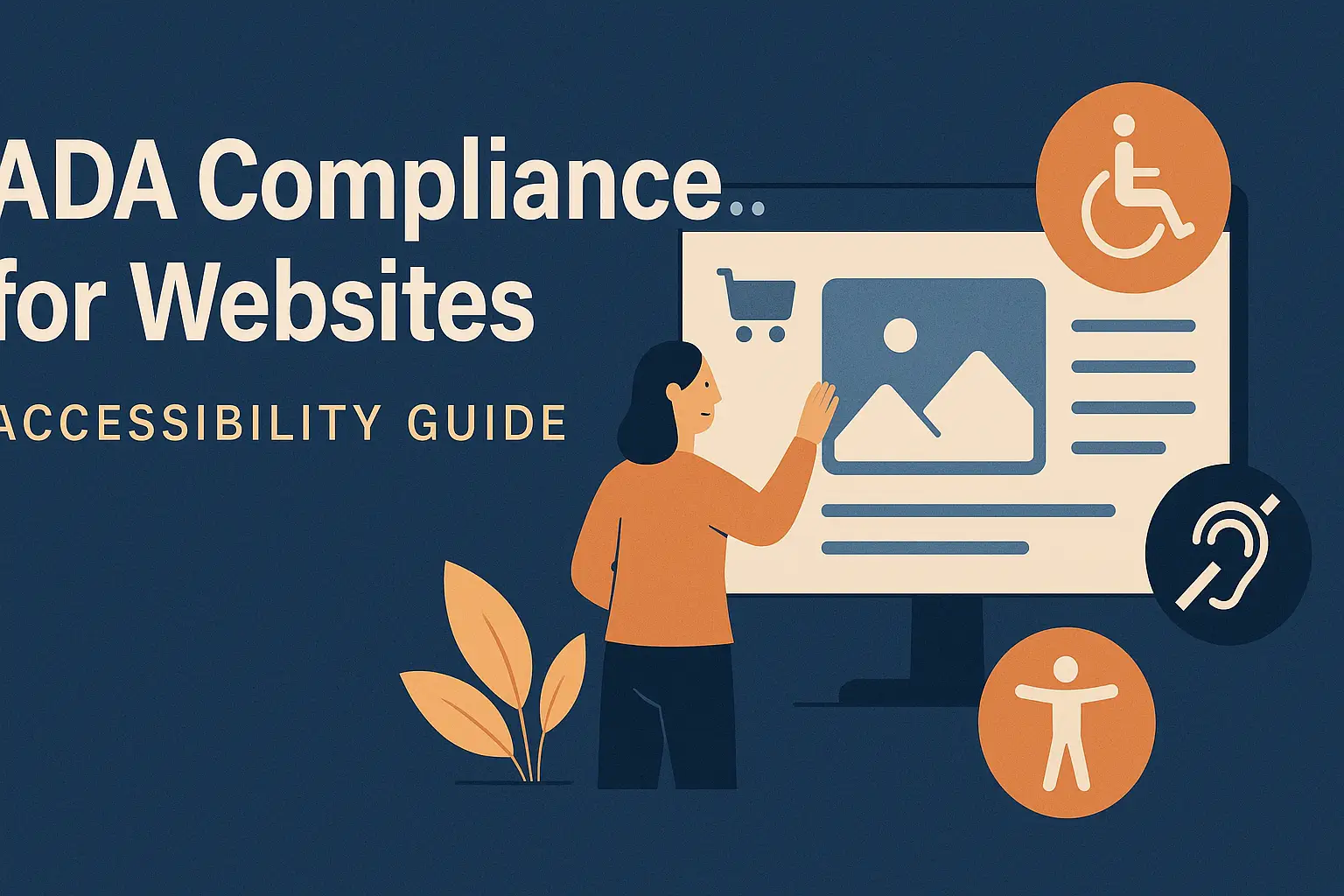
I. Introduction to ADA Compliance
In today’s digital landscape, ADA compliance for websites is not just a nicety; it’s a necessity.. As the internet becomes increasingly integral to everyday life, ensuring that all users can access and navigate websites is paramount. This is where the Americans with Disabilities Act (ADA) comes into play. Originally enacted in 1990 to protect individuals with disabilities from discrimination in various areas of life, the ADA has evolved to encompass digital spaces, including websites.
ADA compliance means that your website must be accessible to people with disabilities, including those who may have visual, auditory, motor, or cognitive impairments. Failing to adhere to these standards not only marginalizes a significant portion of the population but can also expose businesses to legal risks. Lawsuits related to ADA compliance for websites have been on the rise, underscoring the importance of making digital content available to everyone. For more details, see the official ADA.gov Web Accessibility Guidance.
In this guide, we will explore the significance of ADA compliance for websites, outline the key regulations and guidelines that govern accessibility, and provide actionable steps to ensure that your website meets these critical standards. As we delve into the nuances of ADA compliance, you will learn not only the “how” but also the “why” behind creating an inclusive digital environment.
II. Understanding ADA Compliance
A. What is ADA Compliance?
The Americans with Disabilities Act (ADA) was enacted in 1990 to ensure that individuals with disabilities have equal access to all areas of public life, including employment, transportation, public accommodations, and telecommunications. While the ADA does not specifically mention websites, the Department of Justice has stated that online services must be accessible to individuals with disabilities, thereby extending the principles of the ADA to the digital realm. ADA compliance for websites, therefore, refers to the process of making your website usable for people with disabilities, ensuring that they can access and interact with your content effectively.
B. Importance of ADA Compliance for Websites
The significance of ADA compliance for websites cannot be overstated. With over 61 million adults in the United States living with some form of disability, it is essential for businesses and organizations to recognize the importance of accessibility in their digital offerings. By adhering to ADA compliance for websites guidelines, organizations not only ensure equal access for all users but also improve their overall user experience, enhance their brand reputation, and minimize legal risks associated with non-compliance.
Moreover, an accessible website can expand your audience reach, as it allows individuals with disabilities to engage with your content and services. This inclusivity not only provides a better experience for users but can also lead to increased customer loyalty and satisfaction. Ultimately, embracing ADA compliance is not just a legal obligation; it is a fundamental aspect of ethical business practice.
C. Key Regulations and Guidelines
To understand ADA compliance fully, it’s crucial to familiarize yourself with the key regulations and guidelines that govern website accessibility. While the ADA itself does not provide specific technical requirements for web design, the Web Content Accessibility Guidelines (WCAG) serve as the accepted standard for ensuring digital accessibility. Developed by the World Wide Web Consortium (W3C), these guidelines outline specific criteria for making web content more accessible to people with disabilities. The WCAG is structured around four principles: Perceivable, Operable, Understandable, and Robust (POUR).
1. **Perceivable**: Information and user interface components must be presented in a way that users can perceive. This includes providing text alternatives for non-text content, such as images and videos.
2. **Operable**: User interface components must be operable by all users. This means ensuring that all functionalities can be accessed using a keyboard and that users have enough time to read and interact with the content.
3. **Understandable**: The information and operation of the user interface must be understandable. This involves using clear language and consistent navigation, as well as providing error messages and instructions that are easily comprehensible.
4. **Robust**: Content must be robust enough to be interpreted reliably by a wide variety of user agents, including assistive technologies. This entails using standard coding practices and ensuring that your website remains accessible as technologies evolve.
By understanding these principles and aligning with WCAG guidelines, you can take meaningful steps toward achieving ADA compliance and creating a more inclusive online environment.
III. Steps to Make Your Website ADA-Compliant
Making your website ADA-compliant is a critical process that ensures all users, including those with disabilities, can access and navigate your content effectively. Here are the essential steps to achieve compliance:
A. Conducting an Accessibility Audit
The first step in making your website ADA-compliant is to conduct a thorough accessibility audit. This involves evaluating your website against established accessibility standards, such as the Web Content Accessibility Guidelines (WCAG). Here are some key components to include in your audit:
1. **Automated Testing Tools**: Utilize online tools and software that can quickly identify common accessibility issues, such as missing alt text or broken links. However, keep in mind that automated tools may not catch every problem, so manual testing is also necessary.
2. **User Testing**: Engage users with disabilities to navigate your site. Their feedback will provide valuable insights into how real users experience your website, helping you identify specific areas for improvement.
3. **Comprehensive Review**: Review all aspects of your website, including text, images, videos, and interactive elements. Ensure that each component meets accessibility requirements and consider how different disabilities might impact user experience.
B. Implementing Accessible Design Principles
Once the audit is complete, Accessible design principles such as semantic HTML and keyboard navigation are vital for ADA compliance for websites:
1. **Semantic HTML**: Use proper HTML elements (like headings, lists, and tables) to structure your content. This helps screen readers interpret the information correctly, ensuring better accessibility for users with visual impairments.
2. **Keyboard Navigation**: Ensure that all interactive elements, such as buttons and forms, can be navigated using a keyboard alone. This is crucial for users who cannot use a mouse due to mobility impairments.
3. **Color Contrast and Readability**: Maintain high color contrast between text and background elements to enhance readability. Use tools to check color contrast ratios and ensure that font sizes are adjustable for users with visual challenges.
4. **Alt Text for Images**: Provide descriptive alt text for all images, which allows screen readers to convey the content of images to visually impaired users. Ensure that the alt text is concise yet informative, conveying the image’s purpose.
C. Testing for ADA Compliance
After implementing the necessary changes, it is crucial to test your website for ADA compliance to ensure that it meets accessibility standards fully. Here are some recommended testing methods:
1. **Comprehensive Review**: Conduct a detailed review of your website’s design, functionality, and content based on the WCAG criteria. This should include verifying compliance across various devices, browsers, and assistive technologies.
2. **Feedback from Users**: Continue to seek feedback from users with disabilities. Their insights can help identify any remaining barriers and improve overall user experience.
3. **Regular Reassessments**: ADA compliance is not a one-time effort. Regular testing ensures your site maintains ADA compliance for websites as standards evolve.
By following these steps, you can create a more inclusive online environment that accommodates users of all abilities, ensuring your website is not only ADA-compliant but also user-friendly and accessible.
IV. Common ADA Compliance Issues and Solutions
Ensuring your website is ADA-compliant involves addressing various accessibility challenges that can hinder users with disabilities from navigating and interacting with your content effectively. Below, we highlight some of the most prevalent ADA compliance issues and offer practical solutions to rectify them. Many businesses struggle with ADA compliance for websites, facing issues like missing alt text, inaccessible forms, and poor contrast.
A. Missing Alt Text for Images
**Issue:** One of the most common accessibility barriers is the absence of alternative text (alt text) for images. Screen readers rely on alt text to convey information about visual content to users with visual impairments. When this text is missing, these users miss out on critical information that could enhance their understanding of the website’s content.
**Solution:** Always include descriptive alt text for every image on your site. The alt text should succinctly describe the image’s content or function. For decorative images that do not convey meaningful information, use an empty alt attribute (alt=””) so that screen readers can skip them. Regularly review your website’s images to ensure all have appropriate alt text, keeping in mind that clarity and conciseness are key.
B. Inaccessible Forms and Inputs
**Issue:** Forms are essential for user interaction, whether for signing up for newsletters, submitting inquiries, or completing purchases. However, many forms are constructed without accessibility in mind, leading to difficulties for users with disabilities. Common issues include missing labels, unclear error messages, and the inability to navigate forms using a keyboard.
**Solution:** To make forms accessible, ensure that every input field has a visible label associated with it. The use of ARIA (Accessible Rich Internet Applications) labels can also enhance accessibility. Additionally, provide clear instructions and error messages that are easy to understand. Test forms using a keyboard to ensure all fields can be accessed and navigated without a mouse. Regularly solicit feedback from users with disabilities to identify areas for improvement.
C. Poor Color Contrast and Readability
**Issue:** Color contrast plays a significant role in readability. Websites that use low contrast between text and background colors can be challenging for users with visual impairments, including those with color blindness. This can lead to frustration and hinder their ability to engage with your content effectively.
**Solution:** To address this issue, adhere to the Web Content Accessibility Guidelines (WCAG), which recommend a contrast ratio of at least 4.5:1 for normal text and 3:1 for large text. Use online tools to assess color contrast and make adjustments as needed. Additionally, consider using easily readable fonts and sizes, and avoid relying solely on color to convey information. Providing text alternatives for color-coded information can also enhance accessibility for all users.
By proactively addressing these common ADA compliance issues, you can create a more inclusive online environment that welcomes all users, regardless of their abilities. Making your website accessible is not just a legal obligation; it also enhances the overall user experience, fosters greater engagement, and expands your audience reach.
V. Conclusion
In today’s digital landscape, ensuring that your website is ADA-compliant is not just a legal obligation; it is a crucial component of creating an inclusive online experience for all users. By understanding the importance of ADA compliance and the specific regulations that govern it, you can take meaningful steps to enhance accessibility on your website.
As we have outlined, the journey toward compliance involves a thorough accessibility audit, the implementation of accessible design principles, and rigorous testing to identify and rectify any issues. Addressing common pitfalls, such as missing alt text, inaccessible forms, and poor color contrast, is key to fostering an environment where everyone can navigate and engage with your content effectively.
Ultimately, making your website ADA-compliant not only mitigates the risk of legal repercussions but also demonstrates a commitment to inclusivity and respect for all individuals, regardless of their abilities. By prioritizing accessibility, you enhance user experience, broaden your audience reach, and contribute positively to your brand’s reputation.
As you move forward, remember that ADA compliance is an ongoing process. Regularly revisiting your website’s accessibility features and staying informed about evolving guidelines will help you maintain compliance and ensure that your digital presence remains welcoming to all. Embrace this responsibility, and make your website a place where everyone can thrive.
FAQ(Frequently Asked Questions)
What is ADA Compliance for Websites?
ADA Compliance for Websites means ensuring that your website is accessible to people with disabilities. The ADA.gov official guidance outlines how the Americans with Disabilities Act applies online. It involves following guidelines like WCAG to make digital content perceivable, operable, understandable, and robust for all users.
Why is ADA Compliance for Websites important?
It’s important because it ensures inclusivity, enhances user experience, and protects businesses from legal risks. Over 61 million adults in the U.S. live with a disability, so ADA compliance helps reach a broader audience while building brand trust.
What are the benefits of making a website ADA-compliant?
Benefits include better accessibility for all users, improved SEO rankings, reduced bounce rates, higher customer loyalty, and lower legal risks. An ADA-compliant website shows commitment to inclusivity and ethical digital practices.
How do I check ADA Compliance for Websites?
You can use automated accessibility tools like WAVE, Axe, or Lighthouse. However, combining these with manual audits and user testing—especially with people who have disabilities—provides a more accurate compliance check.
What are common issues that prevent ADA Compliance for Websites?
The most common issues include missing alt text for images, poor color contrast, inaccessible forms, lack of keyboard navigation, and videos without captions. Fixing these issues is a big step toward full compliance.
What steps should I take to make my website ADA-compliant?
Key steps include:
Running an accessibility audit.
Using semantic HTML and proper heading structures.
Ensuring strong color contrast and readable fonts.
Adding alt text to all images.
Making forms fully accessible with labels and error guidance.
Testing regularly with real users and assistive technologies.
Is ADA Compliance for Websites required by law?
Yes. The U.S. Department of Justice has confirmed that the ADA applies to websites. Many lawsuits have been filed against non-compliant sites, so ensuring compliance is both a legal requirement and a business necessity.
Does ADA Compliance for Websites improve SEO?
Absolutely. Many accessibility practices—such as alt text, semantic HTML, structured headings, and fast loading speeds—overlap with SEO best practices. An accessible site is more easily indexed by search engines, helping boost rankings.
How often should I review ADA Compliance for Websites?
It’s best to review accessibility regularly, especially after major updates. Technology, design trends, and WCAG guidelines evolve over time, so scheduling quarterly or bi-annual audits keeps your site compliant and inclusive.



